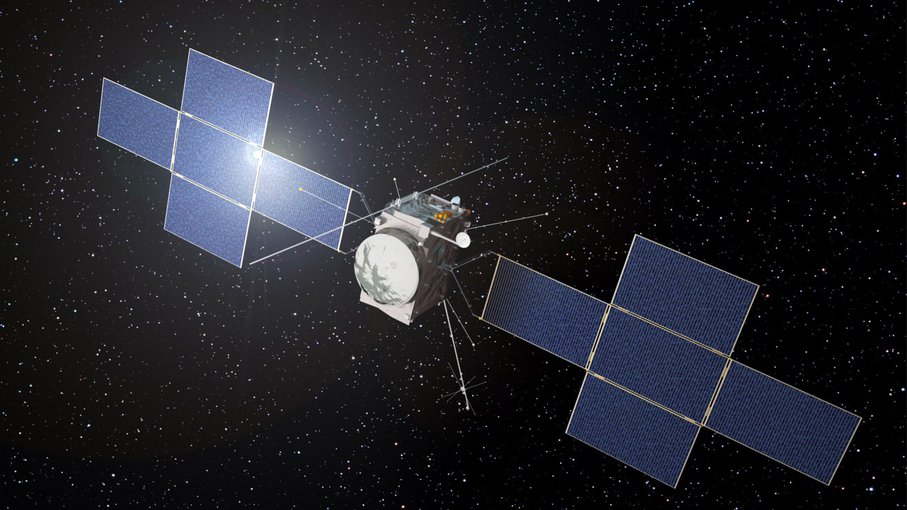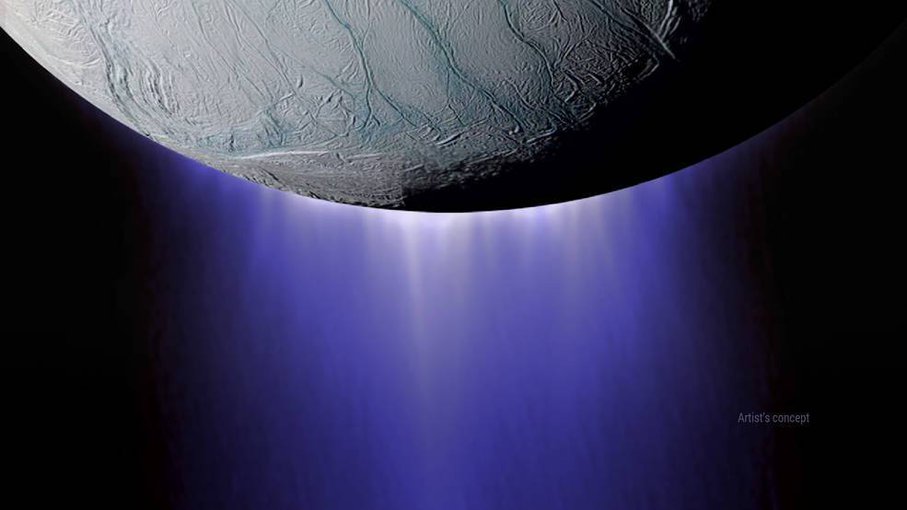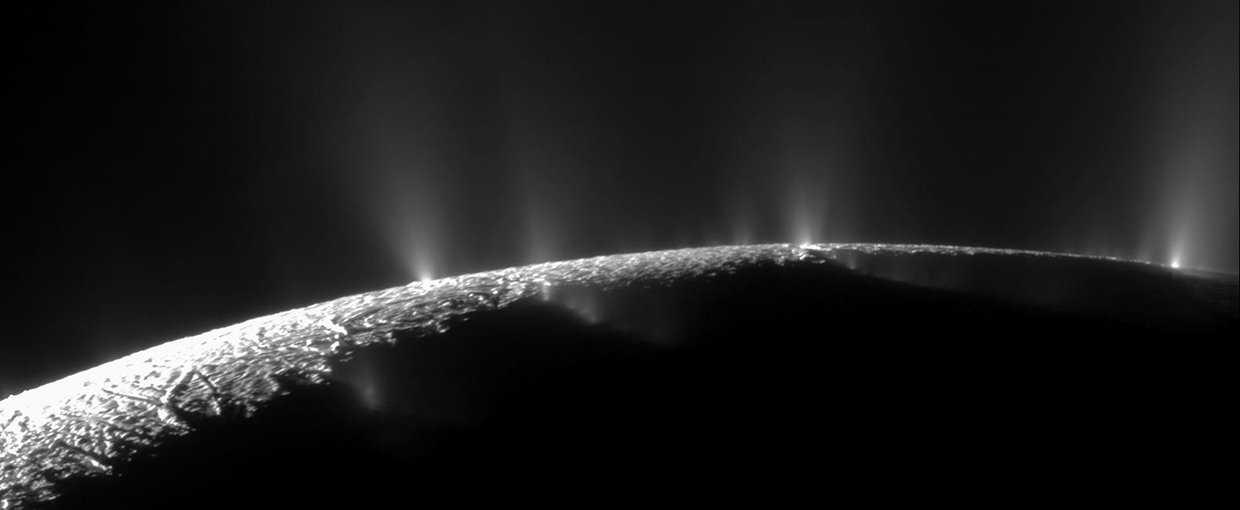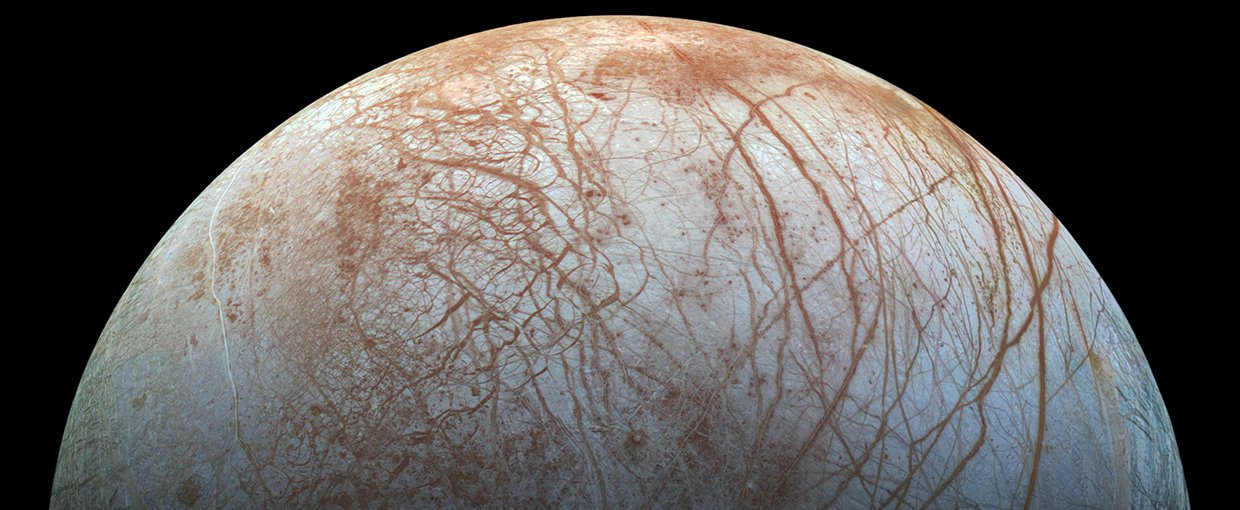
Just about everything that scientists see as essential for extraterrestrial life — carbon, hydrogen, oxygen, nitrogen, phosphorus, sulfur and sources of energy — is now known to be pretty common in our solar system and beyond. It’s basically there for the taking by untold potential forms of life.
But what is not at all common is liquid water. Without liquid water Earth might well be uninhabited and today’s Mars, which was long ago significantly wetter, warmer and demonstrably habitable, is widely believed to be uninhabited because of the apparent absence of surface water (and all that deadly radiation, too.)

This is an artist's illustration of a plume of water vapor being ejected off the frigid, icy surface of the Jovian moon Europa.Image credit: NASA/ESA/K. Retherford/SWRI.
This is a major reason why the discovery of regular plumes of water vapor coming out of the southern pole of Saturn’s moon Enceladus has been hailed as such a promising scientific development. The moon is pretty small, but most scientists are convinced it does have an under-ice global ocean that feeds the plume and just might support biology that could be collected during a flyby.
But the moon of greatest scientific interest is Europa, one of the largest that orbits Jupiter. It is now confidently described as having a sub-surface ocean below its crust of ice and — going back to science fiction writer extraordinaire Arthur C. Clarke — has often been rated the most likely body in our solar system to harbor extraterrestrial life.
That is why it is so important that years of studying Europa for watery plumes has now paid off. While earlier observations strongly suggested that sporadic plumes of water vapor were in the atmosphere, only last month was the finding nailed, as reported in the journal Nature Astronomy.
“While scientists have not yet detected liquid water directly, we’ve found the next best thing: water in vapor form,” said Lucas Paganini, a NASA planetary scientist who led the water detection investigation.

Vents in Europa’s icy crust could allow plumes of water vapor to escape from a sub-surface ocean. If observed up close, the chemical components of the plumes would be identified and could help explain the nature and history of the ocean below.Image credit: NASA.
The amount of water vapor found in the European atmosphere wasn’t great — about an Olympic-sized pool worth of H2O. Looking at the moon from the W. M. Keck Observatory in Hawaii, the scientists saw water molecules on the side of Europa that’s always facing in the direction of the moon’s orbit around Jupiter.
But Paganini’s team registered the faint signal of water vapor just once throughout 17 nights of observations between 2016 and 2017
That fact, Paganini said in a release, was significant. “For me,” he said, “the interesting thing about this work is not only the first direct detection of water above Europa, but also the lack (of more plumes found) within the limits of our detection method.”
More advanced detection equipment certainly might find much more water in the atmosphere, and that possibility is where Europa eclipses Enceladus as the icy moon most likely to give up some of its closest kept secrets in the near term.
Because in the next five years or so, not one but two major missions are scheduled to head for Europa — NASA’s Europa Clipper and the European Space Agency-led JUpiter ICy moons Explorer mission (JUICE.)
Although several missions have been proposed to return to Enceladus with more specialized instruments than the Cassini spacecraft had when it flew through a plumes in 2015, none have been formally approved and funded.
JUICE is scheduled to launch first to Europa — as early as 2022. Because it will need multiple gravity boosts from other bodies to reach the Jupiter system, it is not expected to arrive before the late 2020s.
As for the Europa Clipper, the launch date remains uncertain but estimated to be in the mid 2020s. If it can use the NASA’s super-heavy Space Launch System (SLS) for its launch, it could reach Jupiter and Europa before JUICE. But because of endless delays with the SLS development, and the desire to use its unique lift power if and when it becomes available for launches to our moon and elsewhere, the Clipper may well launch on a commercial rocket and need the same time-consuming boosts.
The Europa Clipper and JUICE missions are different in many ways, but they do have the same Jupiter system and Europa destinations and so are in a race of sorts to be the first to taste Europa’s atmosphere up close.
It’s a cooperative race for sure — NASA does have an instrument planned to ride on the JUICE mission — but who gets there first will be of some space-faring importance just because Europa has long been such a promising destination for scientists.

Jupiter’s moon Europa, as imaged by the Galileo spacecraft in the late 1990s. Europa is the sixth largest moon in the solar system and one of the closest to Jupiter of the planet’s many moons. It has an icy surface crisscrossed with cracks and ridges.Image credit: NASA/JPL-Caltech/SETI Institute.
Some Europa background:
Forty years ago, a Voyager spacecraft snapped the first closeup images of Europa, one of Jupiter’s 79 moons. These revealed brownish cracks slicing the moon’s icy surface, which give Europa the look of an eyeball with criss-crossing veins. Missions to the outer solar system in the decades since have amassed enough additional information about Europa to make it a high-priority target of investigation in NASA’s search for life.
For instance, NASA’s Galileo spacecraft, measured perturbations in Jupiter’s magnetic field near Europa while orbiting the gas giant planet. The measurements, taken between 1995 and 2003, suggested to scientists that electrically conductive fluid, likely a salty ocean beneath Europa’s ice layer, was causing the magnetic disturbances. When researchers analyzed the magnetic disturbances more closely in 2018, they found evidence of possible plumes.
In the meantime, scientists announced in 2013 that they had used NASA’s Hubble Space Telescope to detect the chemical elements hydrogen (H) and oxygen (O) — components of water (H2O) — in plume-like configurations in Europa’s atmosphere. And a few years later, other scientists used Hubble to gather more evidence of possible plume eruptions when they snapped photos of finger-like projections that appeared in silhouette as the moon passed in front of Jupiter.
Lorenz Roth, an astronomer and physicist from KTH Royal Institute of Technology in Stockholm who led the 2013 Hubble study and was a co-author of this recent investigation, said that detecting water vapor on other worlds is especially challenging.
Existing spacecraft have limited capabilities to detect it, he said, and scientists using ground-based telescopes to look for water in deep space have to account for the distorting effect of water in Earth’s atmosphere. To minimize this effect, Paganini’s team used complex mathematical and computer modeling to simulate the conditions of Earth’s atmosphere so they could differentiate Earth’s atmospheric water from Europa’s in data returned by the Keck spectrograph.

The ESA Juice spacecraft is scheduled for launch in 2022 and arrival at Jupiter in 2029. It will spend at least three years making detailed observations of the giant gaseous planet Jupiter and three of its largest moons, Ganymede, Callisto and Europa. Evidence suggests that Ganymede, the largest moon in the solar system, also has a salty ocean beneath its ice core, but little is known about its possible size and location.Image credit: ESA.
They used a spectrograph at the Keck Observatory that measures the chemical composition of planetary atmospheres through the infrared light they emit or absorb. Molecules such as water emit specific frequencies of infrared light as they interact with solar radiation.
So while scientists had evidence that key ingredients for life, including liquid water, were present under Europa’s icy surface and that liquid geysers might sometimes erupt into the atmosphere, nobody had fully confirmed the presence of water in these plumes by directly measuring the water molecule itself. Until, that is, the recent confirmation by by scientists at NASA’s Goddard Space Flight Center and their international partners.
The recent finding of a plume of water vapor in the Europan atmosphere will help scientists better understand the inner workings of the moon. Any lingering doubts have been alleviated about the presence of a liquid water ocean, possibly twice as large as Earth’s, beneath this moon’s miles-thick ice shell. And clearly and importantly, conditions in the ocean would have to be changeable, in some flux, if water is periodically pushed up to the surface and into the atmosphere.
There are, of course, other theories of the source of the Europa plumes. Another is that that the water and vapor comes from shallow reservoirs of melted water ice not far below Europa’s surface. It’s also possible that Jupiter’s strong radiation field is stripping water particles from Europa’s ice shell, though the recent investigation argued against this mechanism as the source of the observed water.
As Avi Mandell, a Goddard planetary scientist on Paganini’s team, put it:. “Eventually, we’ll have to get closer to Europa to see what’s really going on.”

When it arrives at Europa, the Clipper orbiter will conduct a detailed survey of the moon’a surface, deep interior, thin atmosphere, subsurface ocean, and potentially even smaller active vents. The Clipper will attempt to take images of any plumes and sample the molecules it finds in the atmosphere with its mass spectrometers. It will also seek out a safe and promising fruitful site for a proposed (but unfunded) future Europa lander mission.Image credit: NASA/JPL–Caltech.
So if Europa is getting all this attention, why are there no parallel big missions planned to Enceladus? After all, the plumes (or geysers) coming out of the moon are known to be consistent and substantial.
One mission was proposed for last year’s NASA New Frontiers class competition and was well received but ultimately not selected. The German Space Agency has been studying an Enceladus mission since 2012 and Breakthrough Initiative founder Yuri Milner, a Russian billionaire living in the United States, is working with a small NASA team on an simple, relatively inexpensive spacecraft to fly again through the plume and test for organic compounds and possibly by-products of biology.
In effect, Milner and his colleagues believe the possibility of finding life on Enceladus is scientifically too tempting to wait for a full NASA effort — which appears unlikely while the costly Europa Clipper mission is under development.
Briefly, the Enceladus geysers — which sometimes form a curtain of vapor –erupt from the moon’s south polar region. They were first interpreted as being the result of tidally produced pressure and heat in a subterranean sea, with fissures in the ice allowing the water and water vapor to escape. More recently, an even more intriguing source of the needed heat has been proposed.

Saturn’s moon Encedalus sends out regular plumes of water vapor — as seen here as imaged by the Cassini spacecraft — that are known to contain complex organic molecules.Image credit: NASA/JPL-Caltech.
In 2017, an article in the journal Science by J. Hunter Waite of the Southwest Research Institute et al reported that measurements taken during Cassini mission’s final fly-through captured the presence of molecular hydrogen in the plumes. To planetary and Earth scientists, that particular hydrogen presence quite clearly means that the water shooting out from Enceladus is coming from an interaction between water and warmed rock minerals at the bottom of the moon’s ocean– and possibly from within hydrothermal vents.
These chimney-like vents at the bottom of our oceans — coupled with a chemical mixture of elements and organic compounds similar to what has been detected in the plumes — are known on Earth as prime breeding grounds for life. One important reason why is that the hydrogen and hydrogen compounds produced in these settings are a source of energy, or food, for microbes.
A logical conclusion of these findings: the odds that Enceladus harbors forms of simple life increased with the finding, though remain impossible to quantify.
Less is known about the composition of the apparently far more sporadic plumes of Europa, but JUICE and the Europa Clipper will — if they arrive successfully — change that. They too may find a chemical soup conducive to life, and similar signs of deep ocean interactions between the salty ocean and rock minerals heated hydrothermally, through radiation, tidal pressures or perhaps all of the above.
And, no doubt, the precious water and water vapor in those plumes will be the gateway to their understandings.
The Many Worlds Blog chronicles the search for evidence of life beyond Earth written by author/journalist Marc Kaufman. The “Many Worlds” column is supported by the Lunar Planetary Institute/USRA and informed by NASA’s NExSS initiative, a research coordination network supported by the NASA Astrobiology Program. Any opinions expressed are the author’s alone.


